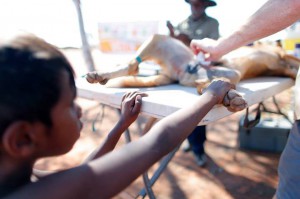Why are whips used in horse racing?
Do whips make horses run faster or win races?
Are jockeys using whips to steer and stay safe, or are they simply whipping tired horses?
These are questions that prompted Professor Paul McGreevy of the University of Sydney to research the use of whips in horse racing.
Paul is recognised by the Royal College of Veterinary Surgeons as a specialist in Veterinary Behavioural Medicine.
His research focuses on the behaviour and welfare of horses and dogs, and he is the author of six books and over 120 peer-reviewed articles on animal behaviour.
Paul’s award-winning research examining the use of whips in horse racing aims to further our awareness of the experience of horses, extending to a recent experiment capturing the thermographic effects of his own leg being hit with a padded whip.
As the Spring horse racing carnival hits its peak in Melbourne, Australia this week, we asked Paul to discuss his findings and what it means for horses, beyond the glamour and excitement of race day.
Podcast
Publications

Thomson, P., Hayek, A., Jones, B., Evans, D., McGreevy, P. (2014). Number, causes and destinations of horses leaving the Australian Thoroughbred and Standardbred racing industries. Australian Veterinary Journal, 92(8), 303-311.
McGreevy, P., Caspar, G., Evans, D. (2013). A pilot investigation into the opinions and beliefs of Australian, British, and Irish jockeys. Journal of Veterinary Behavior: clinical applications and research, 8(2), 100-105.
McGreevy, P., Hawson, L., Salvin, H., McLean, A. (2013). A note on the force of whip impacts delivered by jockeys using forehand and backhand strikes. Journal of Veterinary Behavior: clinical applications and research, 8(5), 395-399.
McGreevy, P., Ralston, L. (2012). The distribution of whipping of Australian Thoroughbred racehorses in the penultimate 200 m of races is influenced by jockeys’ experience. Journal of Veterinary Behavior: clinical applications and research, 7(3), 186-190.
McGreevy, P., Corken, R., Salvin, H., Black, C. (2012). Whip Use by Jockeys in a Sample of Australian Thoroughbred Races – An Observational Study. PLoS One, 7(3), 1-6. [Open Access]
Evans, D., McGreevy, P. (2011). An Investigation of Racing Performance and Whip Use by Jockeys in Thoroughbred Races. PLoS One, 6(1), 1-5. [Open Access]
McGreevy, P., Oddie, C. (2011). Holding the whip hand – a note on the distribution of jockeys’ whip hand preferences in Australian Thoroughbred racing. Journal of Veterinary Behavior: clinical applications and research, 6(5), 287-289.
Paul McGreevy: Google Scholar profile with further publications
Links
Paul McGreevy: University of Sydney
The Conversation: Whips hurt horses – if my leg’s anything to go by
RSPCA Australia position on racehorse whips
Header image used with permission © Liss Ralston










